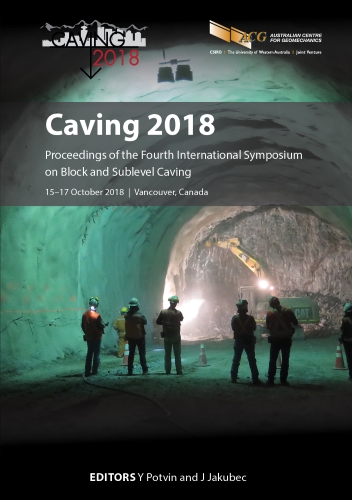Mapping cave front growth utilising the collective behaviour of seismicity and velocity fields

|
Authors: Viegas, G; Bosman, K; Angus, D; de Beer, W; Urbancic, T |
DOI https://doi.org/10.36487/ACG_rep/1815_45_Urbancic
Cite As:
Viegas, G, Bosman, K, Angus, D, de Beer, W & Urbancic, T 2018, 'Mapping cave front growth utilising the collective behaviour of seismicity and velocity fields', in Y Potvin & J Jakubec (eds), Caving 2018: Proceedings of the Fourth International Symposium on Block and Sublevel Caving, Australian Centre for Geomechanics, Perth, pp. 577-588, https://doi.org/10.36487/ACG_rep/1815_45_Urbancic
Abstract:
In many block caving operations, the expansion and growth of the cave involves an examination of the distribution of seismicity both spatially and temporally around the cave itself. These approaches utilise event density as a proxy to define the volume of fractured rock mass and provide a ‘sense’ of cave front migration. However, seismic records contain a wealth of information not only about the location of fractures, but the volume encompassing the fractures (source volume) and the relative stress state of the rock mass surrounding the caving operation with distance from the cave itself. This leads to considering that observed seismicity is part of a collective response of the rock mass due to mining. We suggest that event occurrence is related to the dynamic stress conditions associated with the caving operation. In this manner, we can consider the collective behaviour of seismicity, specifically the energy and stress release states, and map, along with velocity variations, the degree of fracturing relative to the cave boundary. Here, we provide examples of how these approaches enhance our understanding of block caving and the growth of the caving front in space and time. Specifically, we identify how stress can be tracked ahead of the observed event distribution clouds and the relative degree of fracturing that occurs in the highly stressed zone.
Keywords: cave growth, fractures, collective response, stress release, stress tracking
References:
Ardakani, E, Baig, A, Urbancic, T & Bosman, K 2018, ‘Microseismicity-derived fracture network characterization of unconventional reservoirs by topology’, Interpretation, vol. 6, no. 2, SE49–SE61,
Ben-Zion, Y 2008, ‘Collective behavior of earthquakes and faults: Continuum‐discrete transitions, progressive evolutionary changes, and different dynamic regimes’, Reviews of Geophysics, vol. 46, no. 4, RG4006,
Crowley, JW, Baig, A & Urbancic, T 2015, ‘4D tomography and deformation from microseismic data’, Proceedings of the 85th Annual Meeting of the Society of Exploration Geophysics, Society of Exploration Geophysicists, Tulsa.
Kostrov, BV & Das, S 1988, Principles of Earthquake Source Mechanics, Cambridge University Press, Cambridge.
Ma, X, Westman, EC, Fahrman, BP & Thibodeau, D 2016, ‘Imaging of temporal stress redistribution due to triggered seismicity at a deep nickel mine’, Geomechanics for Energy and the Environment, vol. 5, pp. 55–64.
Mercier, J-P, de Beer, W, Mercier, J-P & Morris, S 2015 ‘Evolution of a block cave from time-lapse passive source body-wave traveltime tomography’, Geophysics, vol. 80, no. 2, pp. WA85–WA97,
Nolet, G 2008, A Breviary of Seismic Tomography, Cambridge University Press, Cambridge.
Nur, A & Simmons, G 1969, ‘Stress‐induced velocity anisotropy in rock: An experimental study’, Journal Geophysical Research, vol. 74, no. 27, pp. 6667–6674,
Rawlinson, N & Sambridge, M 2003, ‘Seismic traveltime tomography of the crust and lithosphere’, Advances in Geophysics, vol. 46, pp. 81–198.
Riznichenko, YV 1965, ‘Seismic rock flow’, Dynamics of the Earth’s Crust, Nauka, Moskow, in Russian.
Smith-Boughner, L, Urbancic, T & Baig, A 2017, ‘Resolving sill pillar stress behavior associated with blasts and rockbursts’, in J Wesseloo (ed.), Proceedings of the Eighth International Conference on Deep and High Stress Mining, Australian Centre for Geomechanics, Perth, pp. 257–267.
Urbancic, T, Smith-Boughner, L, Crowley, JW, Viegas, G, Baig, A & von Lunen, E 2015, ‘Characterizing the dynamic growth of a fracture network’, Proceedings of the Unconventional Resources Technology Conference, Society of Petroleum Engineers, Richardson,
Westman, E, Luxbacher, K & Schafrik, S 2012, ‘Passive seismic tomography for three-dimensional time-lapse imaging of mininginduced rock mass changes’, The Leading Edge, vol. 31, pp. 338–345.
© Copyright 2025, Australian Centre for Geomechanics (ACG), The University of Western Australia. All rights reserved.
View copyright/legal information
Please direct any queries or error reports to repository-acg@uwa.edu.au
View copyright/legal information
Please direct any queries or error reports to repository-acg@uwa.edu.au
